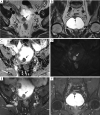Role of magnetic resonance imaging in tumor staging and follow-up for bladder cancer
- PMID: 33457263
- PMCID: PMC7807353
- DOI: 10.21037/tau-19-671
Role of magnetic resonance imaging in tumor staging and follow-up for bladder cancer
Abstract
Urothelial carcinoma of the bladder is a common urologic malignancy. Complex factors, such as local stage, tumor grade, biologic potential, and various conditions, can affect the treatment strategy for bladder cancer. However, the local stage-in particular, the presence or absence of muscle invasion-significantly influences decisions regarding treatment strategy. The role of cystoscopy for screening, diagnosis, and transurethral resection cannot be overlooked. The importance of local staging with magnetic resonance imaging is increasing; magnetic resonance imaging of the bladder is considered a useful staging modality. Moreover, a radiologic reporting system for evaluating and scoring muscle invasion of bladder cancer was recently released. This system is based on multiparametric magnetic resonance imaging and is also expected to be feasible for post-treatment follow-up of bladder cancer. In this review, we discuss the role of magnetic resonance imaging in the local staging of urothelial carcinoma of the urinary bladder and post-treatment imaging. In addition, several technical aspects for obtaining appropriate quality magnetic resonance images of the bladder will be discussed.
Keywords: TNM; Urothelial carcinoma; magnetic resonance imaging; stage; urinary bladder neoplasms.
2020 Translational Andrology and Urology. All rights reserved.
Conflict of interest statement
Conflicts of Interest: Both authors have completed the ICMJE uniform disclosure form (available at http://dx.doi.org/10.21037/tau-19-671). The series “Muscle-Invasive Bladder Cancer” was commissioned by the editorial office without any funding or sponsorship. The authors have no other conflicts of interest to declare.
Figures













Similar articles
-
MRI of Bladder Cancer: Local and Nodal Staging.J Magn Reson Imaging. 2020 Sep;52(3):649-667. doi: 10.1002/jmri.27090. Epub 2020 Feb 29. J Magn Reson Imaging. 2020. PMID: 32112505 Review.
-
Can re-cTURBT be useful in pT1HG disease as a risk indicator of recurrence and progression? A single centre experience.Arch Ital Urol Androl. 2017 Dec 31;89(4):272-276. doi: 10.4081/aiua.2017.4.272. Arch Ital Urol Androl. 2017. PMID: 29473376
-
[The role of the vesical imaging-reporting and data system (VI-RADS) for bladder cancer diagnostics-status quo].Urologe A. 2019 Dec;58(12):1443-1450. doi: 10.1007/s00120-019-01061-3. Urologe A. 2019. PMID: 31741002 Review. German.
-
Clinical staging of upper urinary tract urothelial carcinoma for T staging: Review and pictorial essay.Int J Urol. 2019 Nov;26(11):1024-1032. doi: 10.1111/iju.14068. Epub 2019 Aug 4. Int J Urol. 2019. PMID: 31379021 Review.
-
[Bladder cancer local staging about muscle invasion: 3.0T MRI performance following transurethral resection].Beijing Da Xue Xue Bao Yi Xue Ban. 2020 Aug 18;52(4):701-704. doi: 10.19723/j.issn.1671-167X.2020.04.020. Beijing Da Xue Xue Bao Yi Xue Ban. 2020. PMID: 32773805 Free PMC article. Chinese.
Cited by
-
Recent advances in three-dimensional ultrasound virtual cystoscopy in modeling and local staging for urothelial carcinoma with histopathological correlation: a cohort prospective study.Ann Med Surg (Lond). 2023 Sep 27;85(11):5365-5371. doi: 10.1097/MS9.0000000000001345. eCollection 2023 Nov. Ann Med Surg (Lond). 2023. PMID: 37915685 Free PMC article.
-
Diagnostic performance of multiparametric MRI based Vesical Imaging-Reporting and Data System (VI-RADS) scoring in discriminating between non-muscle invasive and muscle invasive bladder cancer.Pol J Radiol. 2023 Aug 11;88:e356-e364. doi: 10.5114/pjr.2023.130807. eCollection 2023. Pol J Radiol. 2023. PMID: 37701172 Free PMC article.
-
PET Imaging in Bladder Cancer: An Update and Future Direction.Pharmaceuticals (Basel). 2023 Apr 17;16(4):606. doi: 10.3390/ph16040606. Pharmaceuticals (Basel). 2023. PMID: 37111363 Free PMC article. Review.
-
Comparison between biparametric and multiparametric MRI in predicting muscle invasion by bladder cancer based on the VI-RADS.Sci Rep. 2022 Nov 30;12(1):20689. doi: 10.1038/s41598-022-19273-7. Sci Rep. 2022. PMID: 36450813 Free PMC article.
-
VI-RADS score system - A primer for urologists.Int Braz J Urol. 2022 Jul-Aug;48(4):609-622. doi: 10.1590/S1677-5538.IBJU.2021.0560. Int Braz J Urol. 2022. PMID: 35195385 Free PMC article. Review.
References
-
- Soukup V, Čapoun O, Cohen D, et al. Prognostic performance and reproducibility of the 1973 and 2004/2016 World Health Organization Grading classification systems in non–muscle-invasive bladder cancer: a European Association of Urology non-muscle invasive bladder cancer guidelines panel systematic review. Eur Urol 2017;72:801-13. 10.1016/j.eururo.2017.04.015 - DOI - PubMed
-
- Witjes J, Bruins M, Compérat E, et al. EAU guidelines muscle invasive bladder cancer 2018. EAU Annual Congress Copenhagen, 2018.
Publication types
LinkOut - more resources
Full Text Sources
